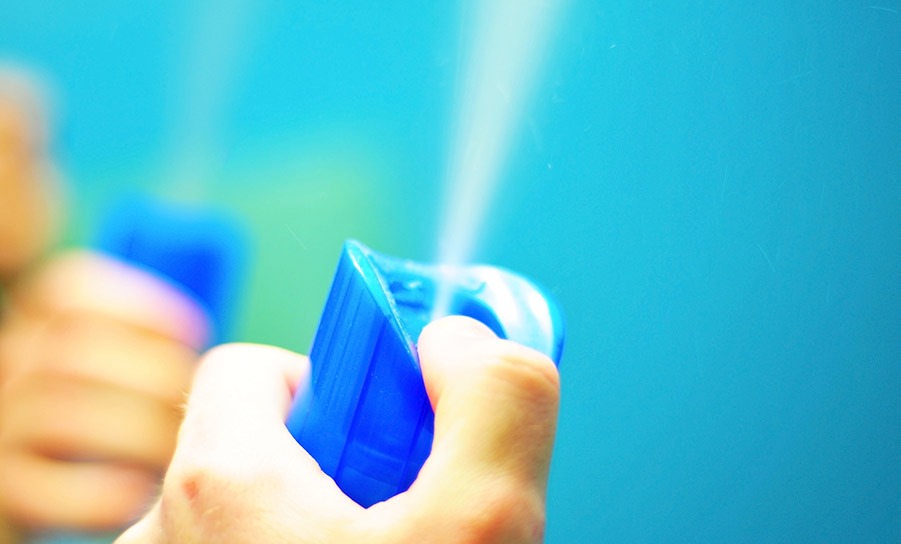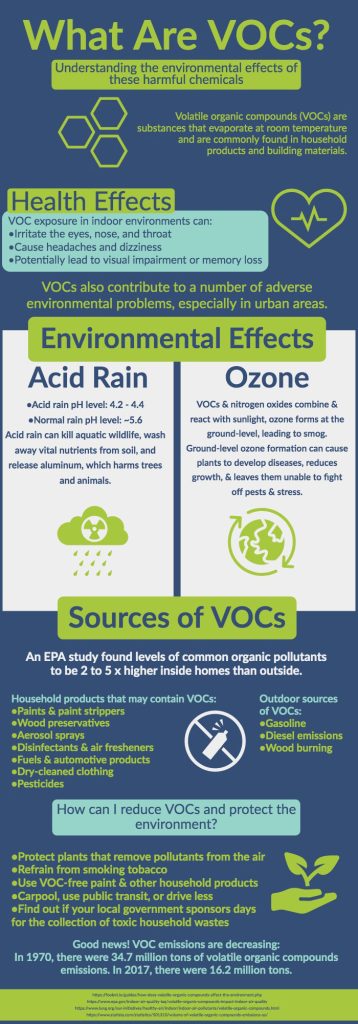
VOCs have come under increasing scrutiny by health professionals, scientists, and consumers all over the world. In the increasing health and eco-conscious consumer market, brands and consumers are opting for products free from VOC’s
So, what are VOCs and how can you avoid them? VOCs are toxic chemicals produced by many everyday products that can seriously affect your health. To help avoid them you can keep your home ventilated, use VOC-less or no VOC products, purify your air, vacuum regularly, and store VOC products appropriately.
This guide will help you to understand what exactly VOCs are, where you can find them, and how to avoid them.
What Are VOCs?
Volatile Organic Compounds (VOCs) are substances that contain carbon that takes the form of vapors or gases. Most likely, you come in contact with VOCs on a daily basis. They can be founds in all the following sources:
- Paints
- Varnishes
- Cleaning products
- Carpets
- Air fresheners
- Bug repellents
- Hobby supplies
- Tobacco smoke
- Printers
- Wood burning stoves
Some of the sources above continue to emit VOCs during transport or storage. VOCs give off a strong scent when present and are deemed bad for your health with excessive exposure to them. The most common VOCs are formaldehyde, benzene, and butanol.
Are VOCs Bad for Your Health?
The inhalation and excessive exposure to VOCs are thought to have a negative effect on your health. It is believed that VOCs can cause both short-term and long-term health effects.
Short-Term Health Effects
- Irritation of eye, nose, throat, and lungs
- Headaches
- Nausea
- Loss of focus and coordination
- Coughing
- Lack of breath
- Pneumonia
- Bronchitis
Long-Term Health Effects
- Damage to liver, kidney and central nervous system
- Anxiety
- Asthma
- Cardiovascular diseases
- Lung cancer
VOCs are currently suspected to cause cancer in humans, including biomarkers for lung cancer. It’s believed that VOCs affect children’s health the most. Some VOCs have been found to cause cancer in some animals too.
The American Lung Association states that VOCs are “harmful by themselves, including some that cause cancer. In addition, they can react with other gases and form other air pollutants after they’re in the air.”
Details on the full range of health effects of specific VOCs can be found on the Agency for Toxic Substances and Disease Registry Toxic Substances Portal.
How To Remove and Avoid VOCs
Thankfully, VOCs can be easily removed from your living spaces using the methods listed below. These methods will help to keep your environment clean and chemical-free.
Use Cleaning Products as Directed
If using cleaning products that contain VOCs be sure not to mix the products. Mixing cleaning products increases the number of VOCs that are emitted during use. Always follow the directions listed on the product’s bottle or packaging. Always keep these products away from children’s reach.
Using eco-friendly or natural homemade cleaning products is the best way to avoid VOCs altogether. Many eco-friendly cleaning products will explicitly label that they do not include VOCs.
Store VOC Products Appropriately
Those with high VOC products in their home should store the products appropriately to avoid VOCs being further emitted into the air.
Try to utilize outdoor storage such as your detached garage or garden shed. This way, any VOCs emitted can be kept away from your home and lost in through the natural escape of air from these buildings.
Store paints, varnishes, and any heavy cleaning supplies in this way.
Increase Ventilation
It’s a good idea to keep your home well ventilated throughout the day by opening doors and windows. If cleaning, you should create as much ventilation as possible to allow fresh air to flow through your home.
Modern homes are built to be airtight to reduce the amount of energy loss in your home. It is especially important for those with airtight homes to increase ventilation so air can escape.
Purify the Air
To get the best results, add a certified air purifier to your home. This will help to eliminate VOCs and any other pollutants in your home. Make sure you buy an air purifier with the right capacity for your home for it to be effective.
Air purifiers with a true HEPA carbon filter are a good choice. More natural solutions include hanging charcoal bags throughout your home which will naturally purify the air for you.
Throw Out Air Fresheners
We all like to have a nice smelling home. Air fresheners are common solutions to covering up nasty smells but they’re also an emitter of VOCs in your home. There is a reason why air freshener cans make you choke as they’re sprayed.
Instead, you can simply open up the windows and allow air to ventilate your living space. Those living in cold regions of the world can make use of essential oils or naturally scented sprays. Always make sure natural alternatives are chemical-free before purchasing.
Vacuum Frequently
Vacuuming on a daily basis might be a lot of effort but it’s a great way of keeping your home clean and free of toxic chemicals. One quick run around a day will help to remove VOCs in your living spaces.
Sometimes vacuums can make things worse by picking up chemicals and spitting them back out into the air. Invest in an airtight vacuum with a HEPA carbon filter to ensure you’re only removing chemicals and not redistributing them.
Buy Natural
A great way to take full control of the VOCs in your home is to have a chemical ban. Stop buying products with toxic chemicals and start buying natural cleaning products only.
The recent surge in the eco-friendly product market means there are now tons of natural options for cleaning, cosmetics, and even appliances. Go chemical-free and remove VOCs effectively.
Buy Low-VOC Products
You can’t always avoid VOCs. When renovating your home you will need to buy paints, varnishes, carpets, and other tools or furniture containing VOCs.
Thankfully, you can now buy products that are “Low-VOC”. You will notice in some hardware and home furnishing stores that products carry this label. You can then be sure you have avoided as many VOCs as possible with your choice.
Choose Low or No VOC Paint
When renovating your home, the regular paints you would buy include a high level of VOCs. Recent initiatives from governments aim to help consumers understand VOCs better and which products contain them.
When choosing paint for your home, do your research and look for the “Low-VOC” label. Other labels may include “Zero-VOC” and “No VOC”.
Upcycle
VOCs are most present in furniture when they’re brand new. The older a piece of furniture the fewer VOCs will be contained in them. This is a great reason to upcycle old furniture for new uses in your home.
Upcycling is also beneficial to the environment and limits your negative footprint on the planet. The internet is full of great upcycling ideas for you to take advantage of.
Final Thoughts
With VOCs present in so many of our everyday products and furniture, it can feel like there is no escape from their toxicity. Using the methods above you can be sure to remove and avoid VOCs to the best of your ability.
VOCs are considered dangerous to our health, especially children. It is important to take any steps you can to help eliminate or avoid them in your home.




